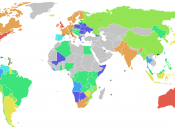There are many macro forces that affect the way The Salvation Army is run.
Factors such as homelessness, race, gender, education and funding sources play a key role in how policies and decisions are made within this non-profit organization.
Arguably one of the poorest cities in America, Hartford it is a city spanning 2,000 square miles (Census), and is also a diverse city: 34% white; 37.5% African American; and 29% Other Races. In 2006, the homeless rate was 4.7, while the city continued to expand and sprawl without much growth in the economy (Census). With such a divergent and growing population, it is little wonder that the homeless rate continues to grow in Harford. Hartford, as well as many other urban cities, relies heavily on support organizations, such as the Salvation Army, in order to provide aid and assistance in monetary, non-monetary, and community support systems (education, moral training, etc.).
C. Wright Mills explains, "Surely it is no wonder. In what period have so many men [generic gender term] have so many men been so totally exposed at so fast a pace to such earthquakes of change?" (Mills 1984). The problem is simply that growth outweighs the ability of the average individual to meet the demands of a growing and confusing economy. Growth does not always mean that jobs are available for all people. The 2006 data set from the Census demonstrates that the population of the city is just over a hundred thousand; however, the median household income is roughly $58,000 and the median price for a home is $240,000. With changing times and a growing city, support is necessary for those individuals who are disenfranchised from achieving good jobs and stable incomes. Due to these demands, the Salvation plays a key role in turning communities around in...


